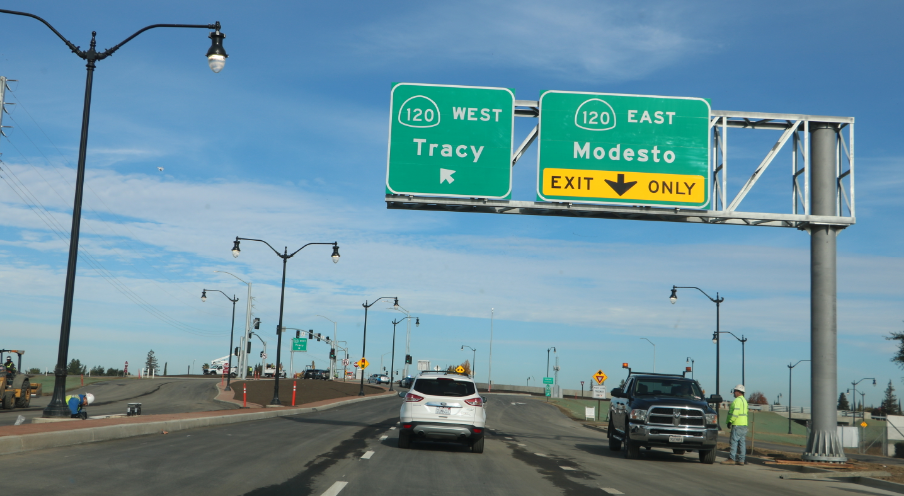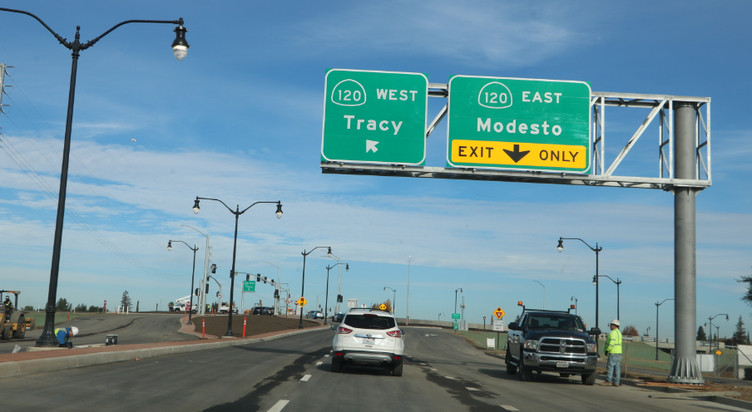It is a subtle sign of the times.
The on-ramp signs for Union Road traffic on the new diverging diamond interchange are obviously on the “wrong side” of the road for what is normal.
But in terms of how times have changed it is what they say that is equally interesting.
The signs read “Tracy” and “Modesto”. It is a far departure than the signs on the original overcrossing configuration as well as the interchanges at Airport Way and Main Street that opened in the 1980s. The signs at those on ramps read “Sonora” and “San Francisco”.
The major flow of traffic in the early 1980s was going from the Bay Area to the Sierra as the epic, solid five-mile long line of traffic on Friday nights heading to the mountains that snaked through downtown Manteca (Yosemite Avenue) that switched directions on Sunday afternoons demonstrated. The Bay Area commute phenomenon was in its infancy and certainly didn’t dominate traffic patterns when the 120 Bypass finally opened a hybrid three-lane highway with interchanges.
Remember in 1980 Manteca was bigger than Tracy boasting 24,925 residents to Tracy’s 18,428. Tracy now has 94,808 residents and Manteca 86,064. Modesto was at 106,963 people back then compared to 218,758 today.
PG&E provides apropos
background to ribbon
cutting ceremony
PG&E crews working on Union Road provided an ironic — and somewhat appropriate — backdrop for Thursday’s ribbon cutting ceremonies for California’s first diverging diamond interchange at Union Road on the 120 Bypass that were conducted in the front parking lot of the Union Road fire station.
It was PG&E — after committing to a date to relocate for transmission poles that allowed a contract to be awarded to Teichert — that blew a hole in the process not taking action of any sort until nearly six months after their committed date. That almost killed the project
At that point — six months after they were supposed to have started work — PG&E got around to raising the issue regarding who was paying for the $1.8 million cost of relocating four PG&E high-power transmission poles needed for the project to proceed. Typically the state and utility providers — in this case PG&E — split the cost 50-50 when power lines need to be relocated for a highway or freeway project based on a master agreement. The paperwork, however, specifically for the Union Road line could not be located.
Without documentation PG&E refused to pay anything for the moving of the power poles. Caltrans, leery of setting a costly precedent declined to pay for more than 50 percent nor did they favor the city picking up PG&E’s share. At one point when the city proposed picking up the entire tab Caltrans — still concerned about statewide implications — withheld blessing such a move and indicated if Manteca proceeded they may be forced to withhold future highway funding from projects involving Manteca.
A deal was made that addressed Caltrans concerns. The next question was where Manteca would get additional funds on top of the $23.7 million Teichert contract that was primarily receipts from the sale of Manteca redevelopment agency bonds and Measure K sales tax funds that covered the cost of the separate pedestrian/bicyclist crossing of the 120 Bypass.
Manteca scrambled to come up with the $1.8 million at the last minute. The San Joaquin Council of Governments delivered $1 million from Measure K half cent sales tax receipts to help save the project. That is how PG&E’s second run at killing the project — obviously not planned — failed.
Three top vote getters
of all time will be on
City Council in December
When the new Manteca City Council takes over in early December once the election results are certified, it will include the three biggest vote getters in city history.
The top two, Gary Singh who was returned for a second term and newcomer Charlie Halford, are No. 1 and No. 2 respectively on that that list.
Singh as of Thursday night with ballots yet to be counted was at 16,047 votes. Halford was at 13,953. Both have eclipsed the previous high mark of 12,042 Ben Cantu set in 2018 when he defeated Steve DeBrum in the mayor’s race. DeBrum is third with 10,988 votes in his unsuccessful bid for a third term as mayor.
While voter turnout was at a record level with a 75 percent turnout of registered voters, gathering record vote levels in this year’s council race was a bit more challenging given there were five candidates seeking two seats. In the 2018 mayors’ race there was only Cantu and DeBrum.
Singh also holds the record for funds raised based on campaign finance documents. He raised $76,071 and has $44,223 left over that represents a nice start for the 2022 mayoral race if he opts to run. Halford, by comparison raised $17,427 and had spent all but $3,364 two weeks before the election.
Based on money spent just prior to the election, Singh spent $31,900 or $1.99 per vote and Halford $14,000 or 99 cents a vote.
Cantu in the 2018 mayoral race spent $30,444 or $2.52 per voter while DeBrum spent $65,000 or $5.91 per vote.
This little mathematical exercise underscores the point that simply raising and spending more money than an opponent does not assure you of victory.
It is an important thing to remember as potential mayoral candidates in the 2022 race weigh their options given Cantu has no money in his campaign account, Singh around $44,000 and Halford — who also could jump into the race — has $3,000 or so depending on how much he spent in the final weeks of the campaign.
To contact Dennis Wyatt, email dwyatt@mantecabulletin.com






